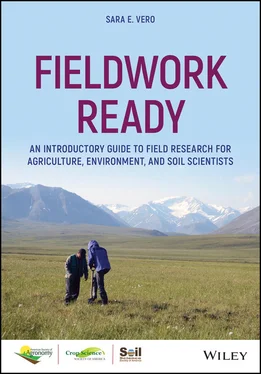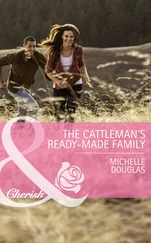1 Cover
2 Title Page
3 Copyright Page
4 Dedication Page
5 List of Photo Contributors
6 Preface
7 Acknowledgments
8 1 Introduction What is “Fieldwork?” Who Does Fieldwork? Why Am I Doing this? References
9 2 Types of FieldworkExperimental Design Monitoring Sampling Design Event Sampling Grab Versus Composite Sampling Sampling for Laboratory Studies References
10 3 PreparationSite Selection Risk Assessment Emergency Equipment Weather Concluding Remarks References
11 4 Logistics Communication The Importance of the “Trial Run” Things Go Wrong! Delays Errors Standard Operating Procedures and Quality Control Vandalism, Theft, and Interference Moving On Taking Care of Yourself in the Field Sample Management Wildlife A Note on Insects Domestic Animals Zoonoses and Biosecurity References
12 5 Environmental Monitoring Resolution, Precision, Accuracy, and Hysteresis Monitoring Arrays: An Overview Components Power Calculation – Example Sensors Matric Potential Step‐by‐Step Installation References
13 6 Soil TechniquesSoil Sampling Equipment Soil Survey Pore‐Water Sampling References
14 7 Water Techniques Surface Water Sampling – Freshwater Instream Parameters Sampling for Laboratory Analysis Sediment (Bed, Bank, and Water Column) References
15 8 PlantsFinding a Slope Randomizing Plots Marking Field Plots Applying Treatment to Field Plots Phenology Vegetation Sampling Root Sampling Plant Height Yield Grain Crops References
16 9 Animal Techniques Live‐Catch Trapping Use of Trail Cameras References
17 End User License Agreement
1 Chapter 3 Table 3.1 Some common fieldwork hazards. Table 3.2 Example tool/equipment list for fertilizer plot study sampling.
2 Chapter 4Table 4.1 Example check‐list for installing a monitoring array.Table 4.2 Common causes of fieldwork delays.
3 Chapter 5Table 5.1 Pros and Cons of low and high data resolution.Table 5.2 Summary of common connection types and descriptions.Table 5.3 Example power demand for data‐logger and volumetric moisture sensor...
4 Chapter 6Table 6.1 Soil particle size classes according toUnited States Department of ...Table 6.2 Some resources for soil taxonomy and classification.
5 Chapter 7Table 7.1 General hold times and storage for common parameters.Table 7.2 Grab sampler designs and their descriptions.
6 Chapter 8Table 8.1 Daubenmire cover classes.Table 8.2 Example of Daubenmire cover class calculationTable 8.3 Example of cover and composition within a quadrat
1 Chapter 1 Fig. 1.1 Researchers investigating a soil pit in Ireland. Fig. 1.2 Field research can take you to some breathtaking scenery. Fig. 1.3 The field is rarely as tidy and organised as the laboratory. Fig. 1.4 A pot study in a glasshouse can be highly controlled. Fig. 1.5 A plot study like this grass trial can be used to examine effects o... Fig. 1.6 Fieldwork is an opportunity to learn practical skills and apply les... Fig. 1.7 In addition to technical skills, fieldwork teaches communication, t... Fig. 1.8 A well designed field experiment allows effective data collection a... Fig. 1.9 Weather information is one category of supplementary data that can ... Fig. 1.10 Always clean and store equipment properly after using it. Don’t le... Fig. 1.11 Collaboration in the field is a great opportunity to learn new ski... Fig. 1.12 Sometimes additional help may be necessary. This team is working t... Fig. 1.13 You may need training in safety protocols. For example, the resear...
2 Chapter 2 Fig. 2.1 Plot and row experiments at a crops research station. Fig. 2.2 Signs like these can be helpful in identifying which plots receive ... Fig. 2.3 Care should be taken when harvesting field trials to accurately rec... Fig. 2.4 Example of a field plot layout including four blocks, each with fiv... Fig. 2.5 (a) Guard rows in row crop trials. (b) Discard area and sampled are... Fig. 2.6 Researchers embarking on a survey in the mountains. Fig. 2.7 Soil surveys are just one form of field work used to develop and va... Fig. 2.8 The researchers in this photo are collecting soil, water and ecolog... Fig. 2.9 Equipment like this eddy covariance tower can be used to monitor at... Fig. 2.10 This phenocam at Konza Prairie, Kansas, provides automated recordi... Fig. 2.11 Monitoring infrastructure such as the weather station at this farm... Fig. 2.12 These researchers are soil sampling in Alaska. There are a variety... Fig. 2.13 Coloured flags are used here to mark where the researcher is ident... Fig. 2.14 GPS devices can be used to accurately identify sampling locations.... Fig. 2.15 Field sampling patterns. (a) W‐pattern, typical for soil survey, (... Fig. 2.16 (a) Line transect record card. (b) Point transect record card. Fig. 2.17 The autosampler shown here uses a pump to extract water samples fr...
3 Chapter 3 Fig. 3.1 Macro‐ to micro‐scale site factors and uses. Fig. 3.2 Consider the distance you will need to travel to reach your sites a... Fig. 3.3 Researchers in this photo lower the risks they encounter by wearing... Fig. 3.4 Specialist training is required for uniquely hazardous tasks and en... Fig. 3.5 Factors influencing the degree of risk associated with a hazard.... Fig. 3.6 Generic hazard and risk assessment template. This should be edited ... Fig. 3.7 While investigating lake sediments this researcher is wearing a lif... Fig. 3.8 Personal protective equipment should be chosen based on the task an...Fig. 3.9 A head flashlight is a valuable piece of equipment as it leaves you...Fig. 3. 10 Although specialist equipment varies, it is helpful to keep some ...Fig. 3.11 Maps are essential for visualizing and understanding the fieldwork...Fig. 3.12 How to find coordinates on a map grid.Fig. 3.13 Sketch of a farm field site (note European date format).Fig. 3.14 Example plot diagram for a field trial. Fig. 3.15 This salamander is taking an interest in one wildlife researher’s ...Fig. 3.16 This researcher is taking careful notes using a pre‐formatted fiel...Fig. 3.17 A well‐maintained notebook is a good alternative to printed field ...Fig. 3.18 The buddy system in action: one reseacher is taking measurements w...Fig. 3.19 Simple soil profile description template. Note that national soil ...Fig. 3.20 Using a tape for scale.Fig. 3.21 Munsell charts or other color checkers can be used to identify and...Fig. 3.22 Check if your PPE is appropriately rated for the hazard in questio...Fig. 3.23 Hi‐vis clothing can help drivers or machinery operators to see you...Fig. 3.24 Keep your PPE clean and in good condition. Store appropriately aft...Fig. 3.25 If you are using boats, all terrain vehicles, snowmobiles or other...Fig. 3.26 All‐terrain‐vehicles can be helpful for accessing difficult to rea...Fig. 3.27 Vehicles can get stuck in snow……Fig. 3.28 or soft ground/mud. Fig. 3.29 This van has been expertly packed for a field trip. This will prev...Fig. 3.30 Heat index risk ranking (Occupational Health and Safety Administra...Fig. 3.31 This researcher is repairing irrigation equipment in humid conditi...Fig. 3.32 Risk of heat‐related disorders (https://www.weather.gov/safety/hea...
4 Chapter 4Fig. 4.1 Face to face meetings give team members the opportuity to discuss t...Fig. 4.2 My team investigating a soil pit! Fieldwork is a great opportunity ...Fig. 4.3 The buddy system can be used in the field for efficient data collec...Fig. 4.4 Data recording issues; (a) unrealistic values, (b) flat‐lined data ...Fig. 4.5 Your head is vulnerable to the cold and to sun. These researchers w...Fig. 4.6 Waders incorporate boots, waterproof trousers and a bib. They shoul...Fig. 4.7 Working in rivers requires specialist clothing such as waders. Chec...Fig. 4.8 Biting or stinging insects such as mosquitos can be extremely irrit...Fig. 4.9 Urine colour is an indicator of hydration status.Fig. 4.10 These researchers are dressed for a long day in the outdoors. Plan...Fig. 4.11 Not all fences will be clearly indicated like this one.Fig. 4.12 Be careful around electric fences. These can give you a nasty or e...Fig. 4.13 Fieldwork can be stressful. Don’t forget to take a moment to appre...Fig. 4.14 Liquid nitrogen is stored in double‐walled containers and maintain...Fig. 4.15 Bulk density sampling equipment including sampling rings (Ø 5 cm),...Fig. 4.16 The wildlife you may encounter on fieldwork varies depending on yo...Fig. 4.17 Domestic animals are responsible for a greater proportion of anima...Fig. 4.18 This gray rat snake is not venomous but be aware of potentially da...
Читать дальше












